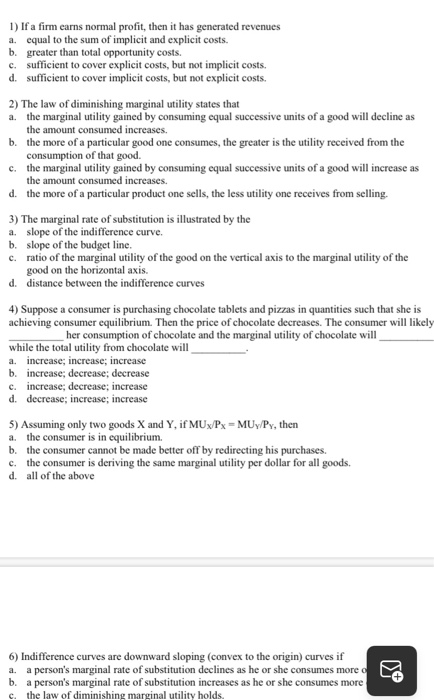1) If a firm carns normal profit, then it has generated revenues a. equal to the sum of implicit and explicit costs. b. greater than total opportunity costs. c. sufficient to cover explicit costs, but not implicit costs. d. sufficient to cover implicit costs, but not explicit costs.
1) If a firm carns normal profit, then it has generated revenues a. equal to the sum of implicit and explicit costs. b. greater than total opportunity costs. c. sufficient to cover explicit costs, but not implicit costs. d. sufficient to cover implicit costs, but not explicit costs.
Chapter6: Demand Relationships Among Goods
Section: Chapter Questions
Problem 6.5P
Related questions
Question

Transcribed Image Text:1) If a firm earns normal profit, then it has generated revenues
a. equal to the sum of implicit and explicit costs.
b. greater than total opportunity costs.
c. sufficient to cover explicit costs, but not implicit costs.
d. sufficient to cover implicit costs, but not explicit costs.
2) The law of diminishing marginal utility states that
a. the marginal utility gained by consuming equal successive units of a good will decline as
the amount consumed increases.
b. the more of a particular good one consumes, the greater is the utility received from the
consumption of that good.
c.
the marginal utility gained by consuming equal successive units of a good will increase as
the amount consumed increases.
d. the more of a particular product one sells, the less utility one receives from selling.
3) The marginal rate of substitution is illustrated by the
a. slope of the indifference curve.
slope of the budget line.
b.
c.
ratio of the marginal utility of the good on the vertical axis to the marginal utility of the
good on the horizontal axis.
d. distance between the indifference curves
4) Suppose a consumer is purchasing chocolate tablets and pizzas in quantities such that she is
achieving consumer equilibrium. Then the price of chocolate decreases. The consumer will likely
her consumption of chocolate and the marginal utility of chocolate will
while the total utility from chocolate will
a. increase; increase; increase
b. increase; decrease; decrease
c. increase; decrease; increase
d. decrease; increase; increase
5) Assuming only two goods X and Y, if MUx/Px = MUY/Py, then
a. the consumer is in equilibrium.
b. the consumer cannot be made better off by redirecting his purchases.
c. the consumer is deriving the same marginal utility per dollar for all goods.
d. all of the above
6) Indifference curves are downward sloping (convex to the origin) curves if
a. a person's marginal rate of substitution declines as he or she consumes more o
b. a person's marginal rate of substitution increases as he or she consumes more
c. the law of diminishing marginal utility holds.
Expert Solution
This question has been solved!
Explore an expertly crafted, step-by-step solution for a thorough understanding of key concepts.
Step by step
Solved in 3 steps

Knowledge Booster
Learn more about
Need a deep-dive on the concept behind this application? Look no further. Learn more about this topic, economics and related others by exploring similar questions and additional content below.Recommended textbooks for you


Principles of Economics 2e
Economics
ISBN:
9781947172364
Author:
Steven A. Greenlaw; David Shapiro
Publisher:
OpenStax



Principles of Economics 2e
Economics
ISBN:
9781947172364
Author:
Steven A. Greenlaw; David Shapiro
Publisher:
OpenStax


Economics (MindTap Course List)
Economics
ISBN:
9781337617383
Author:
Roger A. Arnold
Publisher:
Cengage Learning
